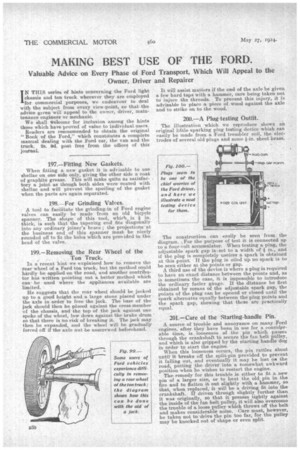• MAKING BEST USE OF THE FORD.
Page 16

If you've noticed an error in this article please click here to report it so we can fix it.
Valuable Advice on Every Phase of Ford Transport, Which Will Appeal to the Owner, Driver and Repairer
IN THIS series of hints concerning -the Ford light chassis and ton truck wherever they are employed for commercial purposes, we endeavour to deal with the subject from every view-point, so that the advice given will appeal to the owner, driver, maintenance engineer or mechanic.
We shall welcome for inclusion among the hints those which have proved of value to individual users. Readers are recommended to obtain the original " Book of the Ford," which constitutes a complete manual dealing with the Ford car, the van and the truck. 2s. 9d. post free from the offices of this journal.
197.—Fitting New Gaskets.
When fitting a new gasket it is advisable to use shellac on one side only, giving the other side a coat of graphite grease. This will make quite as satisfactory a joint as though both sides were coated with shellac and will prevent the spoiling of the gasket when the parts are again separated.
198.—For Grinding Valves.
• A tool to facilitate the grinding-in of Ford engine valves can easily be made from an old bicycle spanner. The shape of this tool, which, is in. thick, is such that the tapering end fits diagonally into any ordinary joiner's brace ; the projections at the business end, of this spanner must be nicely rounded off to fit the holes which are provided in the head of the valve.
199.—Removing the Rear Wheel of the , . . . Ton Truck.
In a recent' hint we explained how to. remove the fear wheel of-a Ford ten truck; but the method could hardly be applied on the road, and another contributor has written pointing out a better method which canbe used where the appliances available are limited. •
He suggests that the rear wheel should be jacked tip to a good height and a large stone placed under the axle in order to free the jack. The base of the jack should then be placed against the cross-member of the chassis, and the top of the jack against one spoke of the wheel, low down against the brake drum so that there is no risk of breaking it. The jack may then be expanded, and the wheel will be gradually forced off if the axle nut be unscrewed beforehand. It will assist matters if the end of the axle be given a few hard taps with a hammer, care being taken not to injure the threads. To prevent this injury, it is advisable to place a piece of wood against the axle and to strike on to the wood.
200.—A Plug-testing Outfit.
The illustration which we reproduce shows an original little sparking plug testing device which can easily be made from a Ford trembler coil, tfie electrodes of several old plugs and some On. sheet brass.
The construction can easily be seen from the diagram. \ For the purpose of test it is connected up to a four-volt accumulator. When testing a plug, the adjustable spark gap is,set to a width of in., and if the plug is completely useless a spark is obtained at this point. If the plug is oiled up no spark is to be seen either at the points or gap.
A third use of the device is where a plug is required to have an exact distance between the points and, as is sometimes the case, it is impossible to introduce the ordinary feeler gauge. If the distance be first obtained by means of the adjustable spark gap, the points of the plug can be opened or closed until the spark alternates equally between the plug points and the spark gap, showing that these are practically equal.
201.—Care of the Starting-handle Pin.
A source of trouble and annoyance on many Ford engines, after they have been in use for a consicterable time, is looseness of the pin which passes through the crankshaft to secure the fan belt pulley, and which is also gripped by the starting handle dog in order to start the engine.' When this looseness occurs, the pin rattles about until it breaks off the, split-pm provided to prevent it falling out, and eventually it may be lost on the road; putting the driver -into a Somewhat awkward position when. he wishes to restart the engine.
The remedy for this trouble is either to fit a_new pin of a larger size, or to heat the old pia in the fire and to flatten it out slightly with a hammer, so that, when replaced, it wilt be a driving fit into the crankshaft. If driven through slightly further than it was originally, so that it presses tightly against the inside of the fan belt pulley, it will also overcome the trouble of a loose pulley which throws off the belt and makes considerable noise. Care must, however, be taken not to drive the pin too far, for the pulley may be knocked out of shape or even split.






























